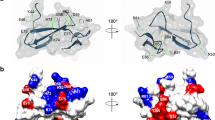Abstract
Recombinant allergen diagnostics have become increasingly important in daily allergological routine, made possible by inroads into the understanding of major and minor allergens accomplished within the last decade. Recombinant allergen diagnostics will, however, only provide correct diagnoses when sufficient knowledge of the regional IgE reactivity profile to a specific allergen source is available. A variety of studies in different European countries revealed reactivity profiles, where a sensitization to house dust mite could be recognized in more than 97 % of cases in which Der p1 and Der p2 were measured. The aim of this study was to investigate the IgE reactivity profiles of house dust mite allergic patients in southern Germany. Sera of house dust mite allergic patients (positive intranasal provocation) were screened for IgE antibodies against commercially available D pter., nDer p1, rDer p2 and rDer p10. IgE antibodies against D pter. could be found in 98 out of 98 sera (100 %). Seventy-five patients (76.5 %) reacted to nDer p1. In 72 patients (73.4 %), IgE antibodies against rDer p2 could be found, while IgE antibodies against rDer p10 were present in only 4 patients (4.1 %). Seventeen patients (17.3 %) had no IgE antibodies against nDer p1, rDer p2 and nDer p10, but displayed reactions to D pter. Knowledge of IgE regional reactivity profiles is necessary when using recombinant allergen diagnostics. In the case of our house dust mite allergic patients 17 would have remained undiagnosed based on a diagnostic method utilizing only the two major allergens nDerp1 and rDerp2.



Similar content being viewed by others
References
Pittner G, Vrtala S, Thomas WR et al (2004) Component-resolved diagnosis of house-dust mite allergy with purified natural and recombinant mite allergens. Clin Exp Allergy 34(4):597–603
Westritschnig K, Sibanda E, Thomas W et al (2003) Analysis of the sensitization profile towards allergens in central Africa. Clin Exp Allergy 33(1):22–27
Hales BJ, Laing IA, Pearce LJ et al (2007) Distinctive immunoglobulin E anti-house dust allergen-binding specificities in a tropical Australian Aboriginal community. Clin Exp Allergy 37(9):1357–1363
Weghofer M, Thomas WR, Kronqvist M et al (2008) Variability of IgE reactivity profiles among European mite allergic patients. Eur J Clin Invest 38(12):959–965
Becker S, Groger M, Canis M, Pfrogner E, Kramer MF (2011) Tropomyosin sensitization in house dust mite allergic patients. Eur Arch Otorhinolaryngol 269(4):1291–1296
Shreffler WG (2011) Microarrayed recombinant allergens for diagnostic testing. J Allergy Clin Immunol 127(4):843–849
Hauser M, Roulias A, Ferreira F, Egger M (2010) Panallergens and their impact on the allergic patient. Allergy Asthma Clin Immunol 6(1):1
Riechelmann H, Bachert C, Goldschmidt O et al (2003) Application of the nasal provocation test on diseases of the upper airways. Position paper of the German society for allergology and clinical immunology (ENT section) in cooperation with the working team for clinical immunology. Laryngorhinootologie 82(3):183–188
Bronnert M, Mancini J, Birnbaum J et al (2012) Component-resolved diagnosis with commercially available d. Pteronyssinus der p 1, der p 2, and der p 10: relevant markers for house dust mite allergy. Clin Exp Allergy 42(1):10–2222
Thomas WR, Smith WA, Hales BJ, Mills KL, O’Brien RM (2002) Characterization and immunobiology of house dust mite allergens. Int Arch Allergy Immunol 129(1):1–18
Thomas WR, Smith WA, Hales BJ (2004) The allergenic specificities of the house dust mite. Chang Gung Med J 27(8):563–569
Trombone AP, Tobias KR, Ferriani VP et al (2002) Use of a chimeric ELISA to investigate immunoglobulin E antibody responses to Der p 1 and Der p 2 in mite-allergic patients with asthma, wheezing and/or rhinitis. Clin Exp Allergy 32(9):1323–1328
Lind P, Hansen OC, Horn N (1988) The binding of mouse hybridoma and human IgE antibodies to the major fecal allergen, Der p I, of Dermatophagoides pteronyssinus. Relative binding site location and species specificity studied by solid-phase inhibition assays with radiolabeled antigen. J Immunol 140(12):4256–4262
Cheong N, Soon SC, Ramos JD et al (2003) Lack of human IgE cross-reactivity between mite allergens Blo t 1 and Der p 1. Allergy 58(9):912–920
Mary CL, Lopez-Malpica F, Diaz AM (2008) Analysis of cross-reactivity between group 1 allergens from mites. P R Health Sci J 27(2):163–170
Hales BJ, Thomas WR (1997) T-cell sensitization to epitopes from the house dust mites Dermatophagoides pteronyssinus and Euroglyphus maynei. Clin Exp Allergy 27(8):868–875
Yasueda H, Mita H, Yui Y, Shida T (1989) Comparative analysis of physicochemical and immunochemical properties of the two major allergens from Dermatophagoides pteronyssinus and the corresponding allergens from Dermatophagoides farinae. Int Arch Allergy Appl Immunol 88(4):402–407
Wandalsen GF, Mendes AI, Sole D (2010) Objective improvement in nasal congestion and nasal hyperreactivity with use of nasal steroids in persistent allergic rhinitis. Am J Rhinol Allergy 24(1):e32–e36
Holmberg K, Tonnel AB, Dreyfus I et al (2009) Desloratadine relieves nasal congestion and improves quality-of-life in persistent allergic rhinitis. Allergy 64(11):1663–1670
Meyer CH, Bond JF, Chen MS, Kasaian MT (1994) Comparison of the levels of the major allergens Der p I and Der p II in standardized extracts of the house dust mite, Dermatophagoides pteronyssinus. Clin Exp Allergy 24(11):1041–1048
Resch Y, Weghofer M, Seiberler S et al (2011) Molecular characterization of Der p 10: a diagnostic marker for broad sensitization in house dust mite allergy. Clin Exp Allergy 41(10):1468–1477
Author information
Authors and Affiliations
Corresponding author
Rights and permissions
About this article
Cite this article
Becker, S., Kramer, M.F., Havel, M. et al. IgE reactivity profiles among house dust mite allergic patients in Bavaria. Eur Arch Otorhinolaryngol 270, 3177–3182 (2013). https://doi.org/10.1007/s00405-013-2516-y
Received:
Accepted:
Published:
Issue Date:
DOI: https://doi.org/10.1007/s00405-013-2516-y




